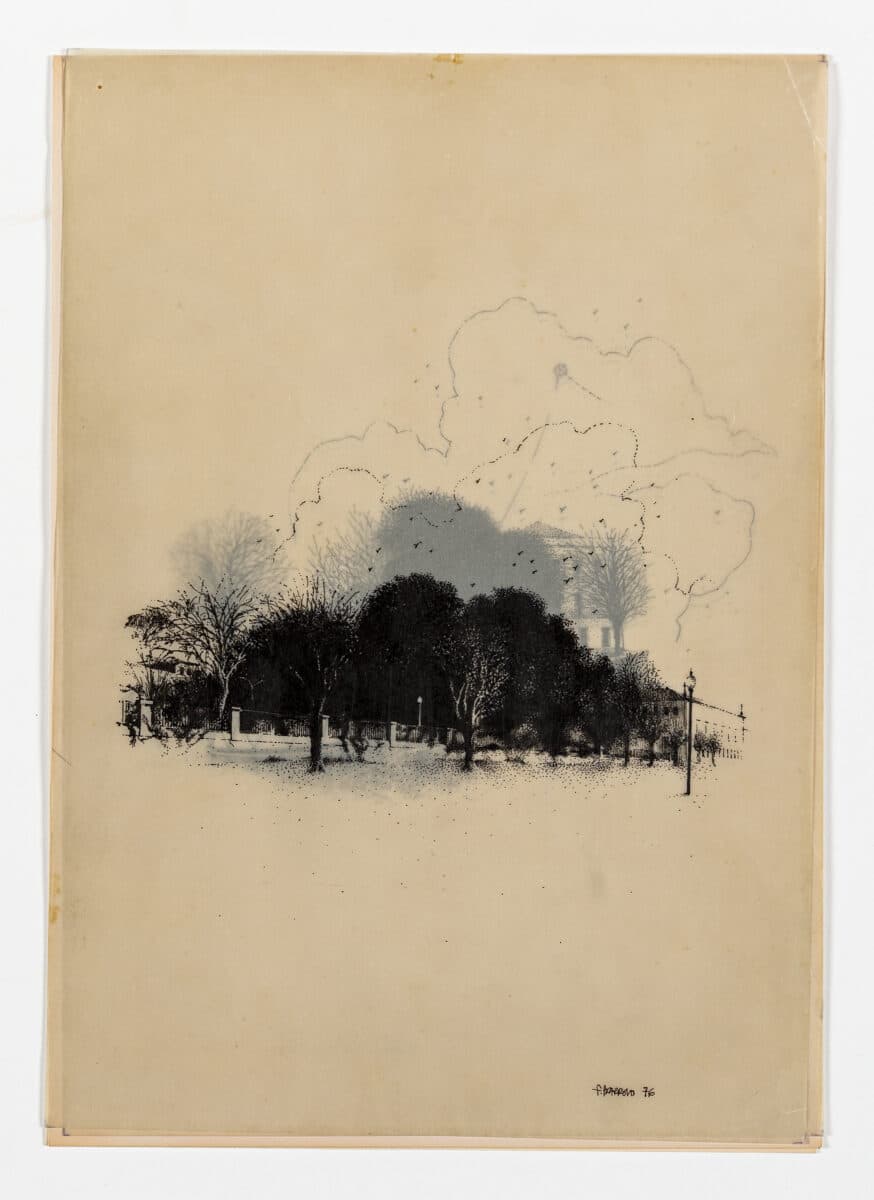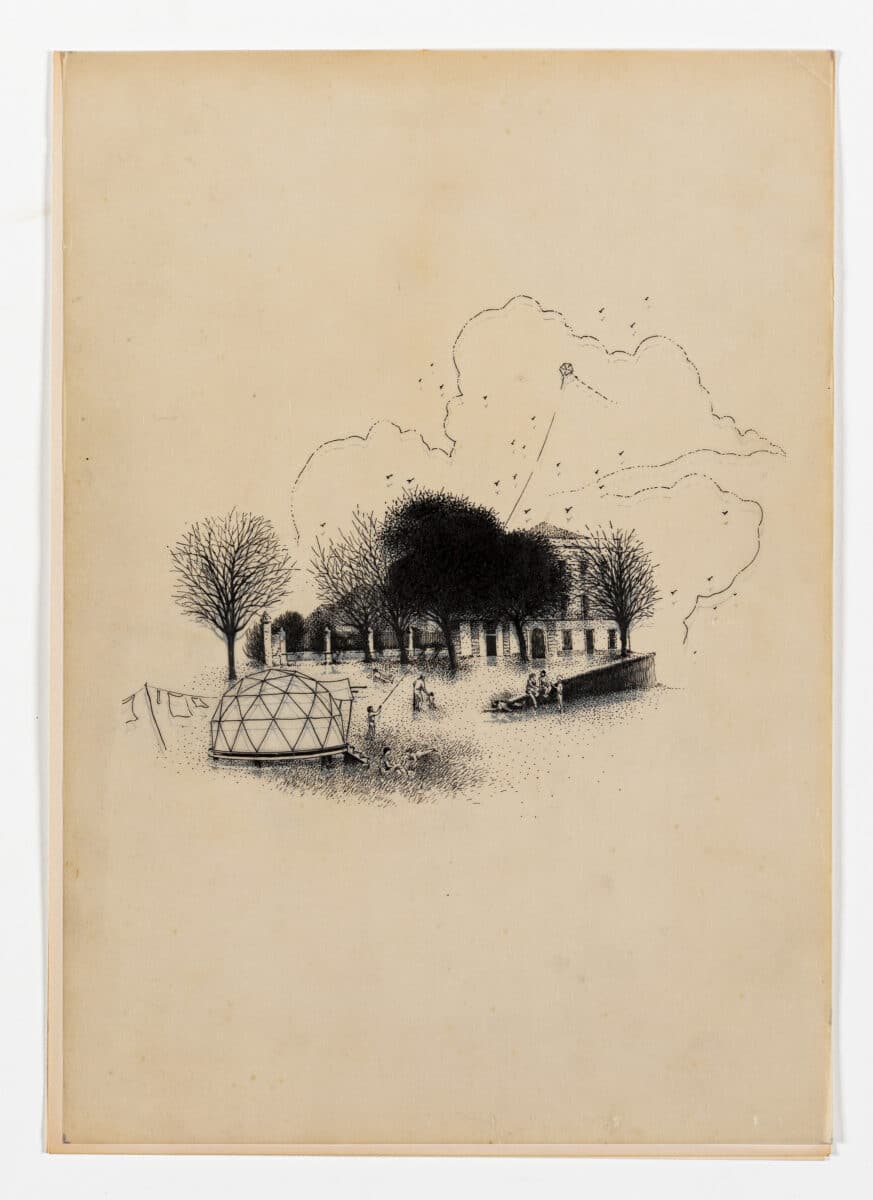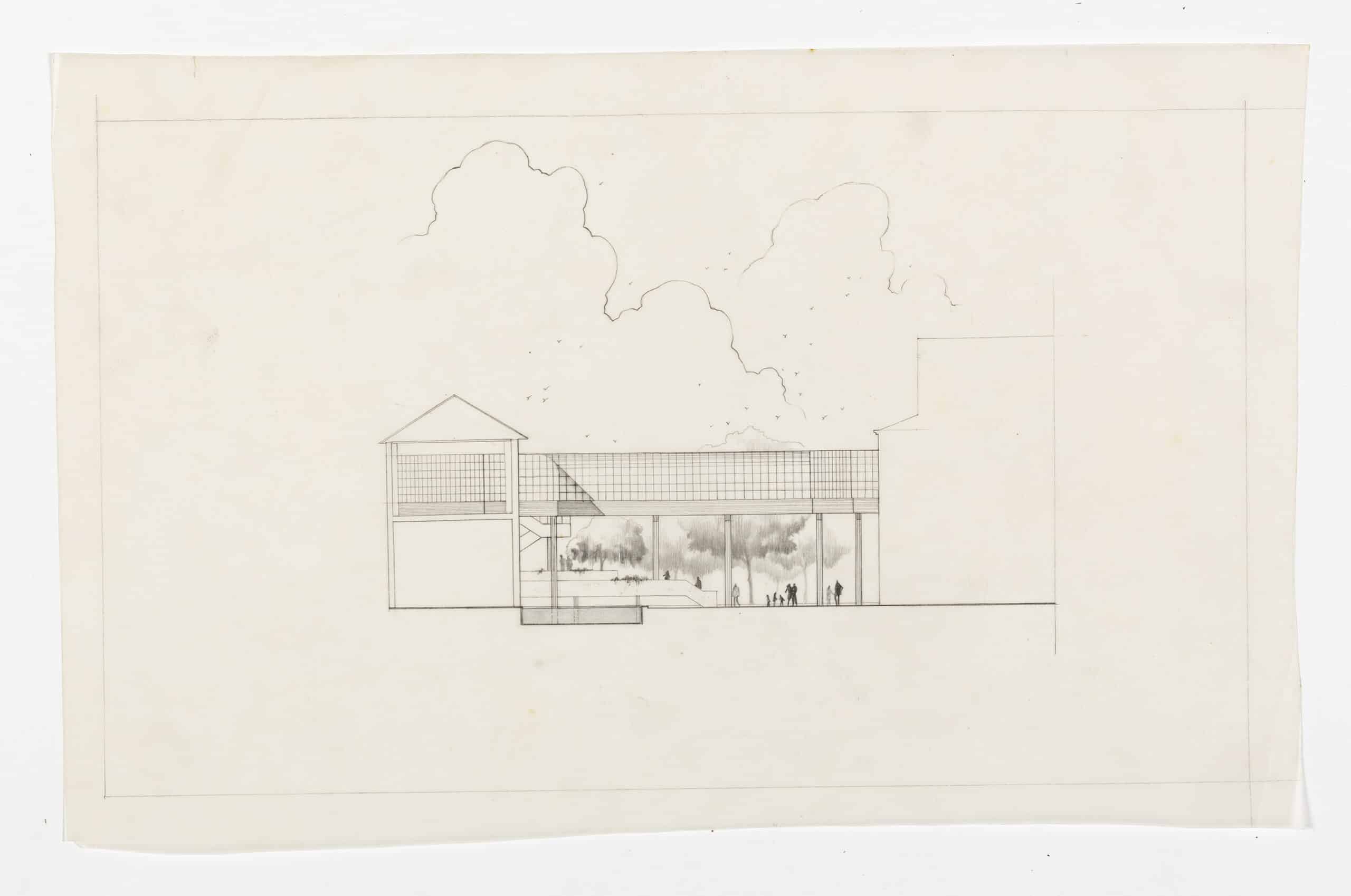The Cod of São Victor
The following text on Mário Ramos and Fernando Barroso’s student work at the Porto School is excerpted from the publication Porto School, B Side 1968–1978 (An Oral History) (CIAJG & Documenta, 2014).
Jacinto Rodrigues recalls that in 1976 Mário Ramos, Fernando Barroso, Graça Nieto Guimarães and Maria de Lurdes Mendonça developed a project to create allotment gardens spanning from ESBAP until the Ribeira riverside district, in the zone of São Victor (consisting of a number of residential quarters, forming a layout similar to that of a dried codfish). [1] But the project was much more ambitious. It began as a radical and provocative plan envisioning the city of Porto without cars and without pavements. The city would be transformed into an open green area, that would appropriate the streets and the house gardens, in a continuous fashion. It also proposed to knock down some walls and, as such, abolish the notion of a border between the public and private space. The plan included gardens and allotment gardens nearly everywhere, assisted by domes that would be used for a wide variety of collective activities.

This work also included various projects with some degree of detail: such as connecting the School of Fine Arts to the Municipal Library with a glassed overhead walkway; the organic outdoor swimming pool complex at Fontainhas; or a funicular linking the various levels of the city; all of this dotted by wind turbine towers. The meticulous drawings show a high graphic sensitivity revealing Fernando Barroso’s prior training (he studied a painting course at ESBAP from 1967 to 1970 and later studied architecture, initially with the intention of delaying being called up for the army). Make Love Not War could very well be the slogan for this imaginary city. Barroso portrayed a ‘timeless city’, a city ‘opposed to reality’.
The publication of this work, called The Need for Utopia, in the third edition of the magazine Revista Alternativa enables us to understand its generic context (although its specific meaning eludes us). [2] Apparently, this project arose as a means to contest the possibility (raised in July 1976) of the architecture course no longer being taught at the School of Fine Arts but, rather, in a building close to the Faculty of Engineering. Although this issue was raised as a reaction to ‘rumours’, it was not such an unreasonable proposal, given that Carlos Ramos has already proposed withdrawing the architecture course from ESBAP (and thereby to become part of the University of Porto) and this would become a reality shortly thereafter. [3] Integrating architecture in the University of Porto was contested by professors such as Arnaldo Araújo, under the concern that the course would thereby lose its autonomy and because they ‘defended a more humanist rather than technological vision of architecture education’. [4]


Returning to the project published in the magazine Revista Alternativa, the article begins by criticising education’s ‘corporatist parcelling’ and remains aware of the ‘weight of the dominating ideology in the production of traditional architecture and urban development projects’, proposing to be an alternative methodology ‘in a critical effort of break away from the models of the dominant society, in an attempt to free the imagination for other forms of creation’. The same article defends a model for the school that is integrated with the city and society, demanding a new institutional model, a ‘centre of multiple activities’ capable of attracting and integrating in its day-to-day activities, not only students, but also children, adults and the elderly, as alternatives to the repressive means of traditional institutions (asylums, schools, police stations, etc.). [5]
It is under this goal that the project advanced, with a connection between ESBAP and São Lázaro Municipal Library, while underlining the ‘malleable and evolutionary’ nature of this new structure. The ‘School becomes unschooled’, and ‘working People can use and appropriate gardens, ponds, swimming pools and the media library of the new ESBAP, a centre that creates many cultural activities (…) and thus a new poetic world is born, where a social community emerges to build a new society free of exploitation and where socialism is also identified with creativity, entertainment and the right to laziness’. It seems almost ironic or contradictory to associate the expression ‘working people’ to the sense of the ‘right to be lazy’, but it can be understood because this last expression is a reference to the political pamphlet written by Paul Lafargue, circa 1880, which inspired the graffiti Ne Travaillez Jamais of Guy Debord. [6]

The proposal’s utopian and somewhat romantic nature is highlighted by the article published in the magazine Revista Alternativa, which refers to the ‘romantic nooks in the garden of happiness’, ‘the poetics of ponds with fish’, the ‘aromatic gardens of one thousand flowers’ and ‘the integrating part of an ecological and communist vision of tomorrow’s world’. The article is not signed, and it does not seem to have been written by Mário Ramos or by Fernando Barroso when compared to what they later wrote in the Insurrectional Organization of Space. But, regardless of the author, this article’s content is, surely, faithful to the environment that prevailed at ESBAP under the influence of Jacinto Rodrigues.
‘Tomorrow’s new world, a world of flowers and domes, of laughter and liberating dreams that fly like the clouds in a large open sky over Porto.’
The Indian ink drawings of Fernando Barroso set the mood for a romantic reading of the project by the effect of the nearly ‘photographic’ and detailed realism, portraying luxuriant vegetation that gives a bucolic facet to the industrial city. Simultaneously, there is something melancholic in these images that seem to denounce the awareness of its utopian limit. If the expository writing is optimistic, coming across as an ‘achievable utopia’ and a futuristic idea, the images seem to refer merely to the past, a nostalgia felt by someone who, in 1976, no longer seems to believe in the revolution.

In the original version of this work, the images were complemented by thirteen posters with collages and writings, created by Ramos and Barroso, which presented a broader view from a social perspective and are also more sophisticated from a poetic perspective, as is shown by these two fragments:
‘Man is no longer using the city, on the contrary: he is manipulated by technicism and by the bureaucracy that pursues a senseless objective – growth for growth’s sake. The city is in crisis, and even moribund; but urban life survives, even if tenuously, which is not a system but a mental and social form based on the value of use, not on the value of exchange. Therefore, conflict between a consumer society and urban reality becomes inevitable, a conflict whose solution is currently being attempted by integrating the urban elements within a social practice whose objective is merely the consumption of objects. Against this situation, one can now only create an integral theory of the new city and of the new urban life, a theory based on redefining the functions of science, art and philosophy and that will notably result in establishing a completely reformulated philosophy’.
‘All issues were forgotten, all reciprocal offences were forgiven; arranged duels were erased from memory and all forms of bitterness dissipated like smoke.’
Notes
- It’s no coincidence that the emblem of the São Victor Residents Association is a codfish drawn by Teresa Fonseca.
- ‘Da Necessidade da Utopi’ in Revista Alternativa #3, October 1977, pp. 12-13.
- The ‘rumours’ referred to the first meeting on 11 June 1976, at the Dean’s Office of the University of Porto, to discuss integrating the Architecture course and its definitive separation from the Belas-Artes (Fine Arts). See Raquel Paulino, op. cit., p. 453.
- Alexandre Alves Costa said that a very aggressive declaration was made when Arnaldo Araújo left. As for the Cooperativa Árvore, they claimed to be the continuity of the ‘Porto School’ since the other would become a ‘Faculty’. About this issue, it is also worth noting that the ‘Reform of 57’, of Carlos Ramos, had the ambition of making architecture education equivalent to university education in order to endow architects with the same status as engineers. The units of physics and mathematics were included in the ESBAP course for that very reason. In the opinion of Domingos Tavares, Arnaldo Araújo had a ‘Vitruvian’ vision of architecture education: the search for transversal and multidisciplinary knowledge and that, in his opinion, the technique was not an autonomous thing, as was taught to engineers, but something that could be learned from a historical and cultural approach.
- Alexandre Alves Costa states that Jacinto defended the idea of school as an ‘atelier of the people’.
- ‘Work, proletarians, work to increase the social fortune and your individual miseries, work, work so that, becoming poorer, you have more reasons to work and be miserable. That is the ruthless law of capitalist production’ in O Direito à Preguiça (Le Droit à la Paresse, 1880) by Paul Lafargue (Portuguese ed., Editorial Teorema, 1977).
